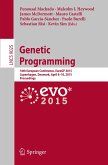Genetic Programming Theory and Practice explores the emerging interaction between theory and practice in the cutting-edge, machine learning method of Genetic Programming (GP). The material contained in this contributed volume was developed from a workshop at the University of Michigan's Center for the Study of Complex Systems where an international group of genetic programming theorists and practitioners met to examine how GP theory informs practice and how GP practice impacts GP theory. The contributions cover the full spectrum of this relationship and are written by leading GP theorists from major universities, as well as active practitioners from leading industries and businesses. Chapters include such topics as John Koza's development of human-competitive electronic circuit designs; David Goldberg's application of "competent GA" methodology to GP; Jason Daida's discovery of a new set of factors underlying the dynamics of GP starting from applied research; and Stephen Freeland's essay on the lessons of biology for GP and the potential impact of GP on evolutionary theory.
From the reviews:
"This book contains 19 chapters that are based on respective research papers presented at the workshop 'Genetic Program, Theory and Practice'. ... The balanced combination of theoretical issues and application issues, along with the many new and interesting results described by the contributors make this book a useful source of up-to-date information on GP. The book will no doubt inspire new and old researchers and practitioners to push further the frontiers of GP theory and practice for the benefit of the international society." (Spyros Tzafestas, Journal of Intelligent and Robotic Systems, Vol. 45, 2006)
"This book contains 19 chapters that are based on respective research papers presented at the workshop 'Genetic Program, Theory and Practice'. ... The balanced combination of theoretical issues and application issues, along with the many new and interesting results described by the contributors make this book a useful source of up-to-date information on GP. The book will no doubt inspire new and old researchers and practitioners to push further the frontiers of GP theory and practice for the benefit of the international society." (Spyros Tzafestas, Journal of Intelligent and Robotic Systems, Vol. 45, 2006)








